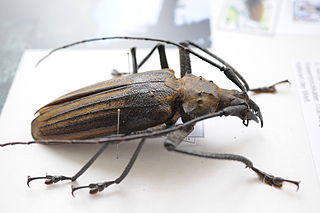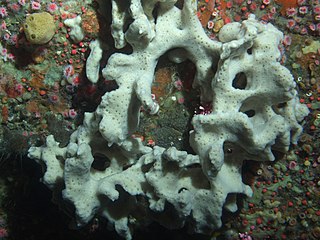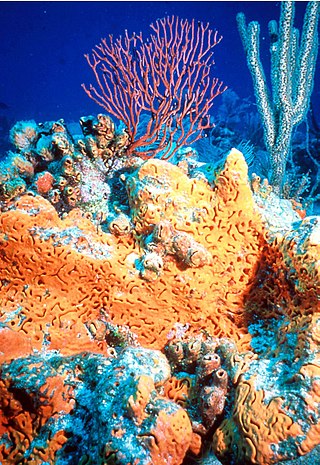
The genus Argiope includes rather large spiders that often have a strikingly coloured abdomen. These spiders are distributed throughout the world. Most countries in tropical or temperate climates host one or more species that are similar in appearance. The etymology of Argiope is from a Latin word argentum meaning silver. The carapace of Argiope species is typically covered in silvery hairs, and when crawling in the sun, they reflect it in a way that gives them a metallic, white appearance.

Xixuthrus is a small genus of long-horned beetles, found primarily on Pacific islands, including Indonesia, New Guinea, the Solomon Islands, and Fiji, and contains some of the largest living insect species, the giant Fijian long-horned beetle and the Taveuni beetle. These beetles have powerful jaws, and should be handled with care when alive. No scientists have yet seen a larva of this genus, although in Fiji, where three different species occur, the natives consider them to be a rare and special delicacy.

Cryptophagidae is a family of beetles with representatives found in all biogeographic realms. Members of this family are commonly called silken fungus beetles and both adults and larvae appear to feed exclusively on fungi although in a wide variety of habitats and situations, such as rotting wood and shed animal fur and feathers. These beetles vary from about 1 to 11 millimeters long, and usually have an oval body shape with a slight "waist".

Chondrocladia is a genus of carnivorous demosponges of the family Cladorhizidae. Neocladia was long considered a junior synonym, but recently become accepted as a distinct genus.

Spongia is a genus of marine sponges in the family Spongiidae, originally described by Carl Linnaeus in 1759, containing more than 60 species. Some species, including Spongia officinalis, are used as cleaning tools, but have mostly been replaced in that use by synthetic or plant material.

Oreta is a genus of moths belonging to the subfamily Drepaninae. The genus was erected by Francis Walker in 1855.

Ircinia is a genus of sea sponges in the family Irciniidae.

Agelas is a genus of sea sponge in the class Demospongiae.

Euplectellidae is a family of glass sponges (Hexactinellids) belonging to the order Lyssacinosa, first represented in the Ordovician fossil record, substantially older than molecular estimates of the clade's age.

Caulophacus is a genus of glass sponges belonging to the subfamily Lanuginellinae.

Odontocolon is a genus of ichneumon wasps in the family Ichneumonidae. There are at least 40 described species in Odontocolon.
Smenospongia is a genus of demosponges in the family Thorectidae.
Amphidiscella is a genus of sea sponge in the family Euplectellidae.
Sceptrulophora is an order of hexactinellid sponges. They are characterized by sceptrules, a type of microsclere with a single straight rod terminating at a bundle of spines or knobs. An anchor- or nail-shaped sceptrule is called a clavule. A fork-shaped sceptrule, ending at a few large tines, is called a scopule. A broom-shaped sceptrule, ending at many small bristles, is called a sarule.

Bolosoma is a genus of pedunculated siliceous sponges belonging to the family Euplectellidae. This genus lives in deep-sea environments and provides a habitat for a plethora of other benthic species, giving Bolosoma an incredibly important ecological role in the ecosystems it is a part of.

Phakellia is a genus of sponges belonging to the family Bubaridae. The genus has a cosmopolitan distribution.
Phycopsis is a genus of sponges belonging to the family Axinellidae. The species of this genus are found in Malesia and Australia.

Pheronematidae is a family of sponges belonging to the order Amphidiscosida.
Hyalostylus is a genus of sponges belonging to the family Euplectellidae.














